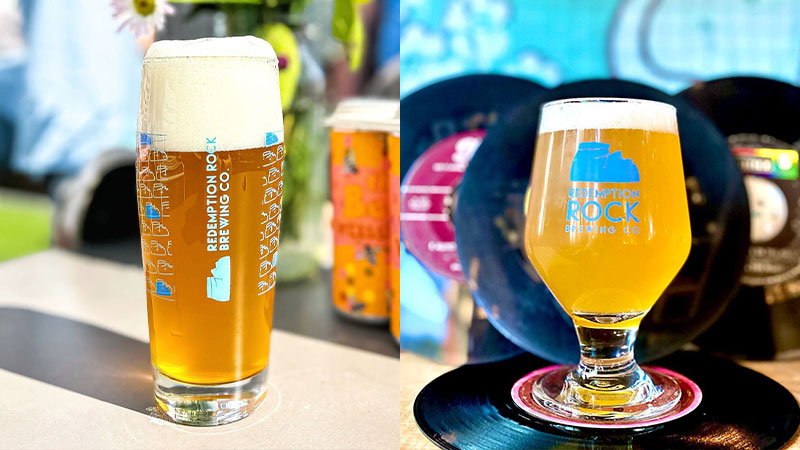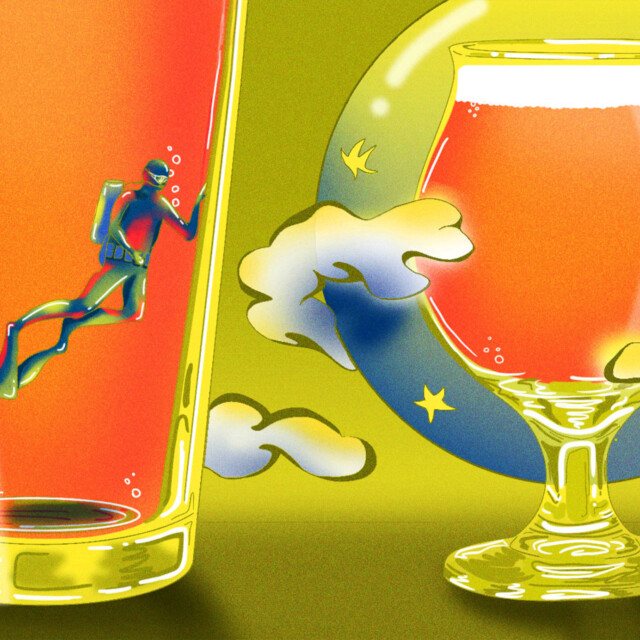There’s a lot I love about the U.K.: ornate edifices that echo of centuries gone by; corner pubs and cafés where conversations lilt on the breeze; the way the sun slants across a horizon that seems closer. But one of my favorite things is telling bartenders: “I’ll have a half.”
The half-pint of beer is standard across the pond, equivalent to just under 10 U.S. fluid ounces ( pints are measured differently in the two countries). Across Europe, sizes such as 250 milliliters, around 8.5 ounces, and 330 milliliters, just over 11, abound. Yet in the U.S., I typically find pours either too large or too small. The half is just right — but it’s maddeningly elusive.
Life, liberty, and the pursuit of proper pours
In the U.K., getting the size of drink you asked for is equivalent to a human right, enshrined in the Magna Carta. It’s still governed today by a law with roots in the 1700s; intended to protect consumers from publicans short-shrifting them, it only allows licensed premises to sell certain state-approved pours of draft beer and cider. And they’re all denominations of the pint, that emblem of British pub culture: the full, half, one-third, and two-thirds (or “schooner,” introduced in 2011).
Yet in America, the land where people are free to serve whatever size they want, many breweries and bars offer fewer options. If a half is served at all, it’s often obscured from the menu and up-charged. I’ve been flat-out denied this request by bartenders, or told that they would serve me a half — at full price.
“I think you should be able to enjoy a beer of any style without having to commit to 16 ounces and still get a proper pour, versus a 4-ounce, which, in my opinion, doesn’t give enough of the beer experience.”
I pretty much never want a full pint of beer. It’s partially a matter of health — my tolerance gets lower and hangovers last longer as I age — and because, like many beer lovers, I want to try lots of new things. And I’m not alone: Inside the industry and out, people want more variety.
“I’m a real lightweight, so [serving] only full pours means I can only have one,” says beer illustrator Em Sauter, “whereas 7–8-ounce pours means I can have three.”
Many breweries offer 4- or 5-ounce tasters to accommodate flights. But to me, these tiny thimbles are no way to enjoy a beer. Mouthfeel, aromas, and tastes are lost; off-flavors may even come forward.
“I think you should be able to enjoy a beer of any style without having to commit to 16 ounces and still get a proper pour, versus a 4-ounce, which in my opinion, doesn’t give enough of the beer experience,” says Jess Keller Poole, director of education at Seattle’s Aslan Brewing Company. “[There’s] usually no head, you can’t stick your nose in it, [and the] glass type allows for aromatic dissipation.”
James Warner, CEO of City-State Brewing in Washington, D.C., says they offer 7-ounce pours for exactly that reason. He went to school in Scotland “and applied everything I learned about beer and pub culture to the brewery,” he says. “I wouldn’t dream of serving without [half-pours].”
Size matters
Customers seem to want them, too — at least the beer connoisseurs. “I love it both as a consumer and as an employee of a bar,” says Seth Feldman, bartender at Beermiscuous in Lakeview, Ill., and founder of beverage consultancy The Boozy Beggar. “I think more places curating a beer list should consider it.”
“It’s all part of an American culture geared toward overconsumption even as addiction soars; a nation raised on scarcity consciousness and zero-sum games.”
Some taprooms and breweries offer an American schooner as their in-between size, and may bill it as a “half.” But it’s actually 12 ounces, two-thirds of a U.S. pint (unless you’re in Texas, where everything is bigger, and it’s 21 ounces).
“In Portland, you can almost always get a shorter pour … but you pay a lot for it. If a pint costs $7, you’ll often pay $6 for 10 ounces,” says beer writer Jeff Alworth, adding that he rarely sees proper halves. “It has been a practice since craft started to deploy ‘non-linear pricing’ — charging a lot more per ounce for shorter pours. I have no idea why breweries/pubs make this choice. You’d think … they’d like to encourage people to sample.”
It’s all part of an American culture geared toward overconsumption even as addiction soars; a nation raised on scarcity consciousness and zero-sum games. From chocolate bars to beers, portion sizes of U.S. food and beverage products have grown since the 1970s, now regularly exceeding health recommendations while nearly 42 percent of adults are obese.
These risk factors are also rising in the U.K., where obesity rates are nearly 26 percent. But if anything, beer sizes there have decreased over time. “The standard draft beer serving until around the end of the 19th century was the ‘pot,’ or quart, and even the pint was a lesser measure,” says British beer historian Martyn Cornell. “[It was] a measure for those who didn’t have time for, didn’t want, or couldn’t afford more.”
Glass houses
This was partially because most people were manual laborers who needed liquid calories; with industrialization, the pint became popular. Interestingly, though, this may have more to do with glassware than culture. According to Cornell, when the Weights and Measures Act was introduced in 1878, all glasses used for draft on licensed premises that claimed to be a certain size had to be stamped with an official number, the seal of the crown, and a geographical identifier — and the allowable sizes were the pint, half-pint, and quart.
Bottles came in the same official sizes, but around the 1920s, the half became popular, along with certain styles. Elderly women developed a particular affinity for milk stout, which came in 10-ounce bottles. Newcastle Brown Ale came in a full-pint bottle, but was served with a half-glass so people could top up its famous head — typically a footed tulip glass, which Cornell calls the best vessel for beer, and I agree.
What’s more, from the 1930s–’60s, draft beer in most British pubs was, well, bad. So customers would order half a pint of draft, then mix it with a half-pint bottle (the “light and bitter” was a split bottled pale and draft bitter). Publicans stocked half-pint glasses to accommodate bottles and those who wanted “a swift one,” Cornell says.
As American-style craft came overseas, “people were used to drinking pints of 4 percent [beer], and still wanted to drink pints — but now they were 7–8 percent,” says Matt Curtis, editor of Pellicle Magazine. “American IPA is delicious [and] easy to drink, so people would get f*cking hammered, and bars would often encourage people to drink a half-pint.”
It was expensive, too. In the U.K., beer is taxed by strength; a local, low-ABV Bitter still costs less than 4 pounds (about $5) at most pubs, but a pint of imported IPA could run 13 pounds (just over $16).
On a trip to London in 2017, as the IPA craze waned in the U.S. and rose in the U.K., it was a revelation to see everyone ordering halves. Back home, everyone was slamming 8 percent pints, a story that horrified my British friends. Perhaps it’s because we don’t have a pub culture; going out is more about brewery-hopping and Untappd rankings than sessioning all afternoon at your local.
Drink like a lad?
While many British owners and patrons saw an opportunity in smaller pours, Curtis says, some clung to the pint as a measure of masculinity. Pub culture has a dark, segregated history: Owners could legally refuse to serve women based on gender until 1982. And another historical name for the half was the “woman’s serve.”
“Large pours of strong beer can be intimidating, and halves are more accessible for people trying to moderate drinking or who are new to craft beer.”
Pub culture birthed “lad culture” in the 1990s: a youth-centered toxic masculinity that festered in the dark corners of drinking spaces and still lingering like the region’s characteristic mold. “When I started going out, you could order a half, but you’d be absolutely stigmatized,” Curtis says. “As a young man, you had to drink the quantity and the volume.”
American craft beer culture has always been bro-centric at best and dangerous at worst, and perhaps this has something to do with size. Some owners say offering fewer pour options is a matter of necessity, crowding menus and shelves and taking extra effort to maintain. But to me, it’s about the message you send.
Large pours of strong beer can be intimidating, and halves are more accessible for people trying to moderate drinking or who are new to craft beer. This often includes women, LGBTQIA+ people, and BIPOC, who already have a slew of aggressions, micro- and otherwise, to worry about. When I see a half on the menu, at least I know I can avoid an uncomfortable conversation that often leaves me feeling pressured into drinking more than I want.
The pint came to the U.S. with the colonists, says beer historian Travis Rupp, redefined as 16 ounces after the British measurement system was abandoned around the end of the 18th century. At the turn of the 20th century, when German immigrants like Adolphus Busch began dominating American beer, it came in 8-, 12-, and 26-ounce bottles (the German standard is 1 liter, or 33 ounces). After Prohibition ended in 1933, only the 12-ounce bottle and can really resurfaced.
Less is more
In the 1950s and ‘60s, corporations that wanted to encourage customers to drink more of their light, mass-produced beer began pushing draft pints. By 1971, the government-run National Institute on Alcohol Abuse and Alcoholism (NIAAA) called “the typical drink” a pint, or 16 ounces, of a 5 percent beer. In 1980, the Dietary Guidelines for Americans (DGA) redefined a “standard-size drink” as 12 ounces, but once America has gone big, it doesn’t go back. Instead, the cans are changing: Today, most breweries sell 4-packs of 16-ounce cans).

Still, things may be starting to shift. More people seem mindful of limiting consumption. Greg Carlson of Redemption Rock Brewing in Worcester, Mass., says instead of flights, they offer 6- and 8-ounce pours — in footed tulip glasses. And halves are common in beer-centric cities like Fort Collins, Colo. Maybe one day we’ll approach the U.K., where in 2015, a CAMRA survey found people’s favorite pour was the half-pint.
As many sizes are at our disposal as types of drinkers — why not bring in more? As for me, I know I’ll feel welcome anywhere I can order a half-pint in a tulip glass, post up at my local, and stay long enough to enjoy things.
